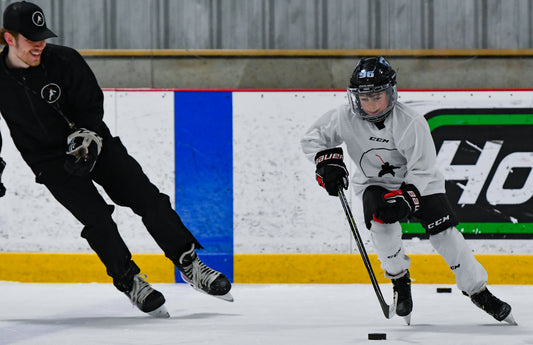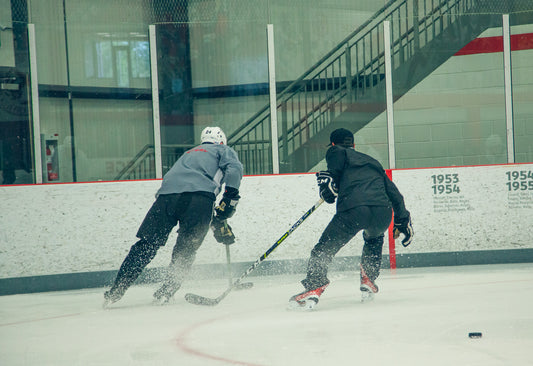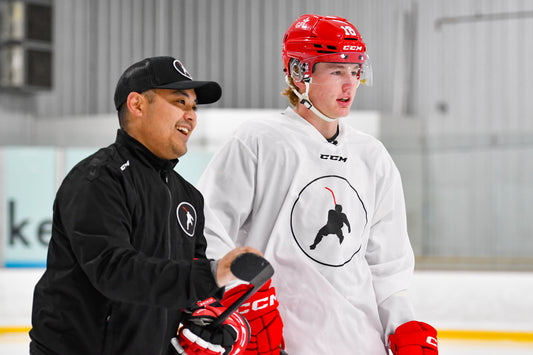We get asked all the time about the effectiveness of a variety of hockey training methods. It must be difficult to navigate as people are trying to sell you stuff all the time. Whether it's skating treadmills, figure skating instructors, drop in clinics, or programs with props, the options are endless. How do you navigate the waters and choose what’s best? Here are 5 common hockey training methods that you should be cautious of and why.
1. Skating Treadmills
Think about it. Skating treadmills were designed as an apparatus to help athletes where there was a void of ice, similar to the running community during inclement weather. This can still be on option if you are in that situation. The biggest reason to avoid the tread is that linear front stride skating represents a whopping 10% of all on-ice movement. Turns, stops and starts, pivots, spins and crossovers both fwd and bwd dominate 90% of the landscape. These patterns cannot be duplicated on a treadmill and are crucial to the success of any on-ice mover. In addition, there are biomechanical imbalances to be aware of.
Glide: A treadmill does not accurately produce the feel of glide that you would get on real ice. While some may point to the added friction as a bonus for conditioning, your nervous system just doesn't map the proper macro movements in this simulated environment.
Control of Body: Because you are suspended in a harness, your posture and weight shift are going to be different then if you were pushing yourself on real ice.
Assistance: On a treadmill you are following the pace of the tread instead of dictating pace based on your own power. The power purpose of your stride is misrepresented as you aren't actually pushing your body anywhere. The quick changes of speed you need in hockey cannot be reproduced naturally on a treadmill.
All of the above can lead to nervous system confusion and muscle imbalance.
The Verdict
Treads were created for research environments when 3D motion capture technology was not sophisticated enough to travel to an ice surface. Not a single NHL player we train uses a tread and we train a lot of them!
2. Figure Skaters Teaching Power Skating
There are aspects of figure skating that we like, and we’ve studied with the best Olympians and looked at the highlights of figure skating doctrine that can help the performance of hockey athletes. However, the nature of figure skating doesn't call for quick changes in speed. Have you ever seen a figure skater do an open hip start to linear front stride, to rudder to quick crossovers? Doubt it.
Figure skaters are all about efficiency and beauty. Hockey is about speed. Even the concept of “edge works” is a buzz word around hockey circles that’s completely misunderstood. The fact is that hockey players shift weight to get to their edge, they are not producing inversion or eversion of the foot like figure skaters do. That’s why the boot of a figure skater is soft, comes up higher and is designed the way it is. Hockey athletes shouldn’t spend time IN their edge, they spend time ON it, and that’s a big difference.
Most importantly hockey athletes need to focus on their weight shift and popping off their edge to maximize speed, not to do a 1 foot swivel.
The Verdict
Figure skaters can help with some of the foundational pieces of balance and control, but its doctrine can’t take you further. Hockey skaters need efficiency and foot speed, agility and deceleration, concepts that are not promoted in the figure skating community.
3. Drop in Programming
We don’t send our kids to school 1 or 2 days a week whenever it’s convenient. We know that doesn’t make sense.
The educational system from the beginning of time was built on teaching a concept and then applying progressive contexts. That means that each concept has a set amount of lessons (the context) that progressively build upon one another. Imagine trying to get through a semester of grade 12 algebra by only dropping in to random classes. We are not robots. We need progressive education, progression that leads each micro context to the next. It’s the only way to make true performance gains.
The Verdict
Drop ins work as a method to try out a new coach or system, but alone are not a viable option for real performance increases.
4. Bungees and Chutes
Another gimmick used mostly in the strength and conditioning industry to get you to buy a) the product and use it yourself or b) programs that utilize the product and claim it’s the next best thing.
Hockey requires combining highly coordinated skills. Skating, stick handling, shooting, etc... are all skills. Kinetically, skating is its most complex. In all of our years of working with the best NHL players we still haven’t met a Perfect Skater. I mean Connor McDavid is awesome, but he still produces asymmetries.
Skating with a bungee or chute causes loaded asymmetries which lead to compensation from other muscles or neural patterns. It doesn’t cure it, it actually makes it worse. Asymmetry production or the increase in compensation of the body is the enemy. It’s like inflammation. Get rid of it and get rid of it fast.
The Verdict
Correcting asymmetries requires the constant repetition of correct movements. Work on asymmetry correction and neural patterns to increase speed. Don’t get slow by loading with chutes and bungees and sold some sort of conditioning program. The human body was meant to move in short explosive bursts with periods of rest. There are many better ways to increase the on-ice conditioning of your athlete heading into training camp!
5. Reactive Programming (Programming with Props)
When designing programming we research different modalities and programs across many athletic industries, then bridge them specifically to our speciality which is hockey performance.
Hockey coaches always seem to do a good job with a first layer: reactive skill. This can be done by skating in, around, and through props. Apparatuses if you will. This 1st layer isn’t bad. However, to move up the depth chart players need to work on dictative skill. The kind where you’re playing a good game of chess with your opponent and you’re always a 1-3 steps ahead. You set them up, you make them bite.

Apparatuses aren’t human which means they can’t move or react to you like an opponent would in a game. That is why you might see them in only the most basic form of our programming. We use active coaches and encourage athletes to work on dictating how the opponent will react which creates higher performance completions.
The other problem we see with reactive programming is a lack of understanding of complexity. For example, let’s have a 10-year-old AAA player go through a maze of props with their head down the entire time. That may help with some basic skills but it doesn't teach them the nuances of deception and getting your opponent to react to you, instead of you reacting to them. We can't stress enough the important of in-game transfer which is why have engaged coaches instead of props.
The Verdict
Try not to get caught up in the hype of fancy looking tools. Look for programs that encourage athletes to dictate movement and skill to transfer to performance gains.
When deciding on how to make the most of your individual training in both the off-season and throughout the year, focus on progression over drop ins, real ice vs treads, speed vs edge work, asymmetry correction vs compensation and active coaches vs props. In our experience, elite players have FUN playing and practicing the game but become inspired, passionate and move to a new level of development when they are surrounded by programs of growth.




